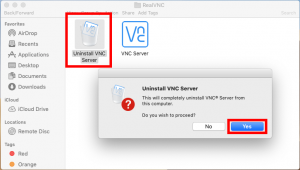

The -23005 error is just what happens when the client disconnects. So there needs to be a separate MiniVNC application for each specific color mode or resolution - this comes from me trying to have it operate as fast as possible. The reason it is freaking out with thousands of colors right now is that I don't do any color translation right now. That you say it is "fairly usable" right now is a good sign and my guess is that the performance can be improved further by some degree. I am going to try implementing some compression and see if I can improve things. Ultimately, it needs to spend less time doing the compression than it would spend sending the data uncompressed. Those would vastly conserve bandwidth on the 256 or thousands of color modes (and maybe even the 16 color mode), but the CPU has to do work to compress a particular region of the screen. So, a lot of ideas - I just have to try them and see what works Right now, I send the screen data entirely uncompressed, but the VNC protocol provides many compression options. This would effectively apply some position dependent noise to the image and make it so things like highlighting or scrolling generated different results without requiring the extra storage a Fletcher sum would require. Another idea I had was to try a simple XOR again, but intentionally set or clear a single bit on each byte at different positions for each row. So effectively my checksum right now is rubbish that probably still chunks things in 32-bit groups, while ignoring every eighth row.Īll this was before I read about Flectcher's sums, which is what I probably want to try next, although it would consume twice as much memory as I am now using. I tried to be clever by using one 32-bit ADD and an AND with 0圎FEFEFEF to try to get something like four 8-bit ADDs in parallel, but on later reflection, I found out this was wrong in many ways. More specifically, I'm looking for VNC server software(s) that would run on both 68K and PowerPC. The program can connect to other computers running VNC Server, or to computers running other remote access software, such as Microsoft Remote Desktop. The application is cross-platform and can be used on different systems.
#VNC SERVER FOR MAC FOR FREE#
Google searching for generic terms was useless, for example 'VNC Server Mac OS' only gets you results about Mac OS X. VNC Viewer downloads for free on the App Store, and it’s compatible with both Mac and Windows. However, since I am able to send change rectangles aligned on an 8-pixel boundary, using a 32-bit grouping causes unnecessary waste on the side of the change rectangle, and more network traffic. I'm looking to run a VNC server on some of my Macs running Mac OS so that I can access them from other machines.

It actually is, but only because it means the carry causes the sum of one column to spill into the next, so effectively 32 columns are treated as a group, effectively increasing the odds of detection. I then tried a plain ADD in the mistaken assumption it would be better than XOR. At first I tried a plain XOR with interesting results on menu items.


 0 kommentar(er)
0 kommentar(er)
